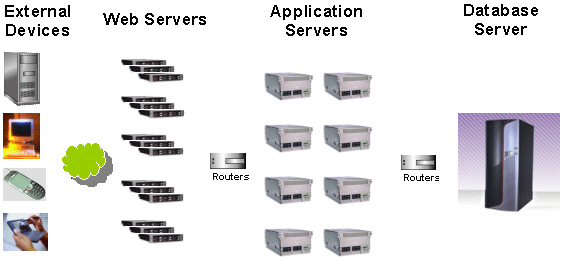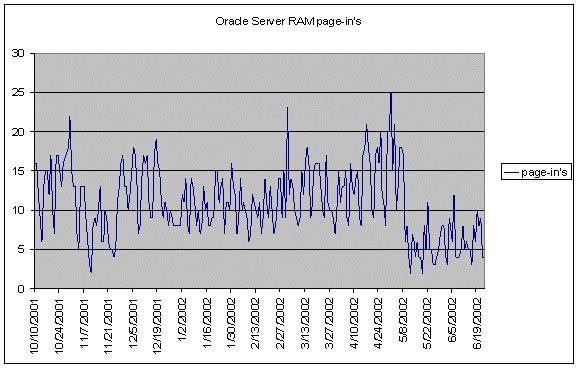Please see these updates to Oracle hardware
architectures and
the
costs and benefits of server deconsolidation.
It is ironic that what was
old is now brand-new again. When I started in "data
processing" in the 1970's I was in an age when a single
server would commonly host a dozen databases.
Things were much simpler in the pre-relational days of
"glass house" servers. With IMS or IDMS on a mainframe, I
would only need to perform an upgrade once, and I could
easily gen-in the upgrades to dozens of "instances," all at
my leisure. Back them there was "the" DBA, and few shops
needed more than one DBA to manage all of the databases.
This all changed in the late '80s with the introduction on
mini-computers. These cheap servers could be purchased for
as little as $30k, a bargain when compared to the $3 million
dollar cost of a mainframe. As minicomputers evolved into
the UNIX-centric Oracle servers of the 1990s some shops
found themselves with hundreds of servers, one for each
Oracle database.
We also saw the age of multitiered applications in which a
large system might be comprised of an Web server layer, an
application server layer, and a database layer, each with
dozens of individual servers (refer to figure 1).

Figure 1: The multi-server architecture of the 1990s.
For Oracle databases, the multi-server architecture employs
Oracle Real Application Clusters, a processing architecture
that allows multiple Oracle instances (often on separate
servers) to access a common Oracle database.
Now we are seeing a resurgence in popularity of large
monolithic servers.
These mainframe-on-a-stick servers may contain 16, 32, or
even 64 CPUs and have processing capabilities that dwarf the
traditional mainframe ancestors on the 1980s.
Many of these new pseudo-mainframes use the latest Intel
Itanium II 64-bit chipset (refer to figure 2). Larry Ellison
mentioned the Intel chips during his presentation at
OracleWorld 2003 in San Francisco when he noted, :If you
want the world's fastest processors, you are going to be forced to pay less."

Figure 2: The Intel Itanium II chipset [source Intel].
Some vendors are assembling these Intel processors into
configurations that are surprisingly similar to their
mainframe ancestors (refer to figure 3).

Figure 3: The UNISYS 16-way ES7000 Server.
These machines are capable of blistering performance and a
recent UNISYS benchmark exceeded 250,000 transactions per
minute on a Windows-based server using Oracle10g.
While the details of the benchmark are included in the link,
the high speed was primarily as result of these factors:
-
115 gigabyte total data buffer cache
-
16 CPU Server : Each a 64-bit Itanium 2 Processor
As a side-note, here are a few of the Oracle10g
parameters that were used in the benchmark:
db_block_size = 2048
db_16k_cache_size = 15010M
db_8k_cache_size = 1024M
db_cache_size = 8096M
db_keep_cache_size = 78000M
db_recycle_cache_size = 15400M
db_writer_processes = 4
pga_aggregate_target = 0
sort_area_size = 65525
Also of interest is the Oracle10g Windows registry
entry ora_lpenable for large page support:
"ORA_LPENABLE" = "1"
This tells Oracle to use the Large Page feature (available
in Oracle9i 64-bit for Windows and Oracle10g 32-bit
and 64-bit for Windows).
The Age of Consolidation
There are naysayers who argue that it is not a good idea to
throw everything into a single server because it introduces
a single point of failure. In reality, these large systems
have redundant everything, and with the use of Oracle
Streams for replication at different geographical locations,
they are virtually unstoppable.
Everything from disk, CPU RAM, and internal busses are
fault-tolerant and redundant, making the monolithic approach
very compelling to large corporations. We also see the rapid
depreciation rates for servers contributing to the move
toward server consolidation.
Three year-old Oracle servers that cost over $100k and now
worth less than $5k and IT managers are looking at a
single-server approach for a variety of reasons:
-
Lower costs : Monolithic server are
extremely good at sharing computing resources between
applications.
-
Lower maintenance : Instead of
maintaining 30-copies of Oracle and the OS, you only need
to manage a single copy.
Part of the problem with single-server Oracle systems was
the deliberate over-allocation of computing resources. Each
system experiences periodic processing "spikes," and each
server had to be equipped with additional resources to
accommodate the infrequent demands of applications. This led
to a condition in which hundreds of Oracle servers had
unused CPU and RAM resources that could not be easily
shared. In the following, (refer to figure 4), we see an
Oracle server that has to have 70 percent more RAM than the
average utilization, a significant waste of expensive
resources, but required to maintain performance during
infrequent bursts of activity.

Figure 4: Deliberate over-allocation of RAM resources on
a single Oracle server.
Cost savings aside, we see other compelling reasons to
consolidate dozens of Oracle instances onto a single server:
-
Oracle server consolidation : Server
consolidation technology can greatly reduce the number of
Oracle database servers.
-
Centralized management : A single server
means a single copy of the Oracle software. Plus, the
operating system controls resource allocation and the
server will automatically balance the demands of many
Oracle instances for processing cycles and RAM resources.
Of course, the Oracle DBA still maintains control and can
dedicate Oracle instances to a single CPU (processor
affinity) or adjust the CPU dispatching priority (the UNIX
"nice" command) of important Oracle tasks.
-
Transparent high availability : If a CPU
fails, the monolithic server can re-assign the processing
without interruption. This is a more affordable and far
simpler solution than Real Applications Clusters or
Oracle9i Data Guard, either of which requires duplicate
servers.
-
Scalability : Using a single large
server, additional CPU and RAM can be seamlessly added for
increased performance.
-
Reduced DBA workload : By consolidating
server resources, the DBA has fewer servers to manage and
need not be concerned with outgrowing their server.
So, what does this mean to the Oracle DBA? Clearly, less
time will be spent installing and maintaining multiple
copies of Oracle, and this will free-up time for the DBA to
pursue more advanced tasks such as SQL tuning and database
performance optimization. But the sad reality of server
consolidation is that thousands of mediocre Oracle DBAs will
loose their jobs to this trend. The best DBAs will continue
to find work, but DBAs who were used for the repetitive
tasks of installing upgrades on hundreds on small servers
will be displaced.
A Peek into the Future
Over the next five years we will see other important changes
in Oracle database administration, and this will forever
change the way that Oracle DBAs perform their work:
-
Fully-cached databases
: Just as the UNISYS benchmark used 115 gigabyte data
buffers, many Oracle systems will become fully cached.
-
Solid-state Oracle : We will also see the
advent of Solid-State Disk (SSD) as a faster replacement
for the archaic spinning platters of magnetic-coated
media.
-
Back to the mainframe : The Oracle system
of the future will run an entire corporate enterprise on
two servers, a main server and a geographically distant
failover server.
-
Changing role of "the" DBA : A single DBA
will be able to manage dozens of Oracle instances in a
consolidated environment, and entire teams of DBAs will be
dissolved, leaving a single "super DBA." This is
reminiscent of the 1980s, when "the" DBA for a large
corporation was required to have credentials (advanced
degrees) and skills far exceeding the typical Oracle DBA
of the late 1990s.
Having experienced the huge flood of need for Oracle DBAs in
the early 1990s as the direct result of server
de-consolidation, I welcome the return to the old days where
I could manage dozens of Oracle instances within a single
server environment.
 |
Here is an example
of a server consolidation where a set of three IBM
P590 Regatta class servers (each with 18 CPU's and
128 gig of RAM) replaced several hundred
minicomputers.
Using IBM's
virtualization tools, Oracle instances can be
partitioned into logical partitions (LPAR's), while
sill maintaining the ability for critical tasks to
use all CPU resources for super-fast Oracle parallel
query. |
 |
If you like Oracle tuning, you
might enjoy my book "Oracle
Tuning: The Definitive Reference", with 950 pages of tuning tips and
scripts.
You can buy it direct from the publisher for 30%-off and get instant
access to the code depot of Oracle tuning scripts. |
